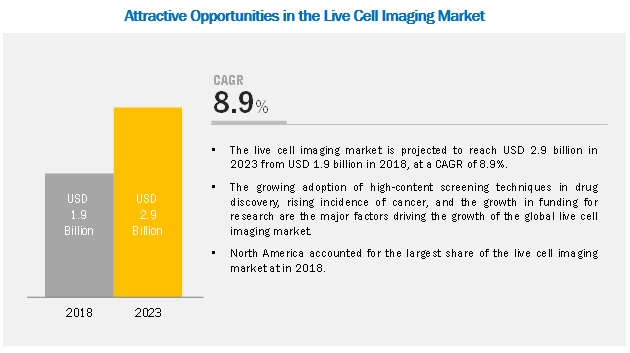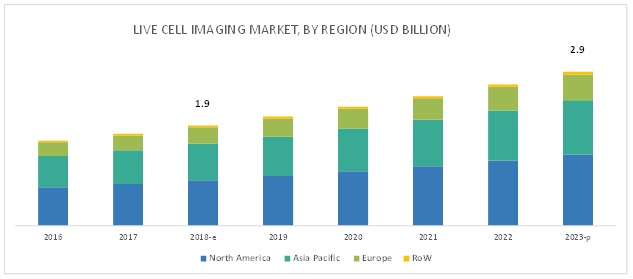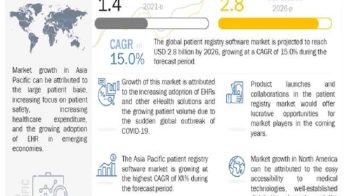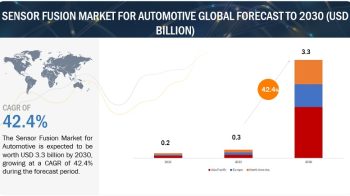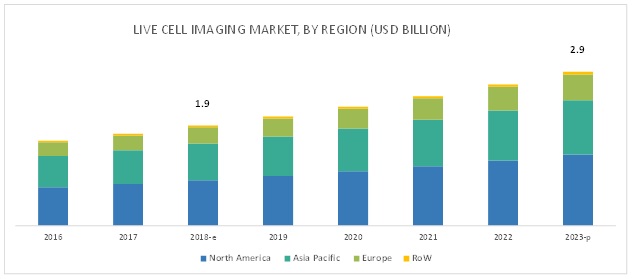
Live Cell Imaging Market in North America Region at a CAGR of 8.9%
The growing adoption of high-content screening techniques in drug discovery, rising incidence of cancer, and the growth in funding for research are the major factors driving the growth of the global live cell imaging market. However, factors such as the high cost of high-content screening systems and the shortage of skilled professionals are expected to restrain the growth of this market during the forecast period.
How much is the Live Cell Imaging Market worth?
MarketsandMarkets forecasts the Live Cell Imaging market to grow from USD 2.9 billion by 2023 from an estimated USD 1.9 billion in 2018, at a CAGR of 8.9% during the forecast period. Factors such as the high cost of high-content screening systems and the shortage of skilled professionals are expected to restrain the growth of this market during the forecast period. The global Live Cell Imaging market is segmented into four major regions, namely, North America, Europe, the Asia Pacific, and the Rest of the World. In 2018, North America accounted for the largest share of this market majorly due to the growth in biomedical research in the US, rising preclinical activities by CROs and pharmaceutical companies, and growing stem cell research in Canada.
The instruments segment accounted for the largest share of the market in 2018
On the basis of product and service, the global live cell imaging market is segmented into instruments, consumables, software, and services. In 2018, the instruments segment accounted for the largest share of the live cell imaging market. Factors such as the launch of new and advanced instruments, increasing incidence of diseases, and rising government initiatives and awareness programs for promoting cell-based research are the major factors driving the demand for live cell imaging instruments.
The academic & research institutes segment is expected to grow at the highest CAGR during the forecast period
On the basis of end user, the live cell imaging market is segmented into pharmaceutical & biotechnology companies, academic & research institutes, and contract research organizations (CROs). The academic & research institutes segment is expected to grow at a higher CAGR during the forecast period. The high growth in this segment can be attributed to the increasing focusing of academic and research institutes on strengthening their own drug discovery research programs coupled with rising government funding to support research and advancing scientific goals.
Download PDF Brochure @
https://www.marketsandmarkets.com/pdfdownloadNew.asp?id=163914483
The stem cells segment is expected to grow at the fastest rate during the forecast period
On the basis of application, the live cell imaging market is segmented into cell biology, stem cells, developmental biology, and drug discovery. The stem cells segment is expected to grow at the highest CAGR during the forecast owing to the increasing stem cell research activity and investments.
North America to account for the largest market size during the forecast period.
North America is the major revenue generating region in the live cell imaging market. The live cell imaging market in the region is driven by the availability of government funding for life science research, drug development regulations, advances in live cell imaging techniques, growth in the biotechnology and pharmaceutical industries, and the rising incidence of cancer.
Request for Sample Pages @
https://www.marketsandmarkets.com/requestsampleNew.asp?id=163914483
Who are the leading vendors operating in Live Cell Imaging Market?
Danaher Corporation (US), Carl Zeiss AG (Germany), Nikon Corporation (Japan), Olympus Corporation (Japan), PerkinElmer, Inc. (US), GE Healthcare (US), Bruker Corporation (US), Thermo Fisher Scientific Inc. (US), Sartorius AG (Germany), BioTek Instruments (US), Etaluma, Inc. (US), CytoSMART Technologies (Netherlands), and NanoEnTek Inc. (Korea).
Danaher dominated the live cell imaging market in 2017. The company is a global leader in live cell imaging and has been operating in the market for about 50 years. Innovation is the prime strength of the company, on the basis of which, Danaher has been able to expand its product portfolio, enter new markets, and build a better network for increasing its customer base.
- Leica Microsystems (a subsidiary of Danaher Corporation) entered into an agreement with Triolab AS, a leading distributor of diagnostics and life science products.
- In September 2018, Leica signed an agreement with Triolab to enable the latter supply and support Leica Microsystems’ confocal, and stereo microscope systems for the life science industry and sample preparation products for electron microscopy.
- Carl Zeiss AG entered into a partnership with the Carl R. Woese Institute for Genomic Biology (IGB) (US).
- In March 2017, Carl entered into a partnership with the Carl R. Woese Institute for Genomic Biology (IGB) to provide researchers around the US with access to the advanced technologies offered by Zeiss including the ZEISS Celldiscoverer 7, at IGB’s Core Facilities.
Speak to Analyst @ https://www.marketsandmarkets.com/speaktoanalystNew.asp?id=163914483
